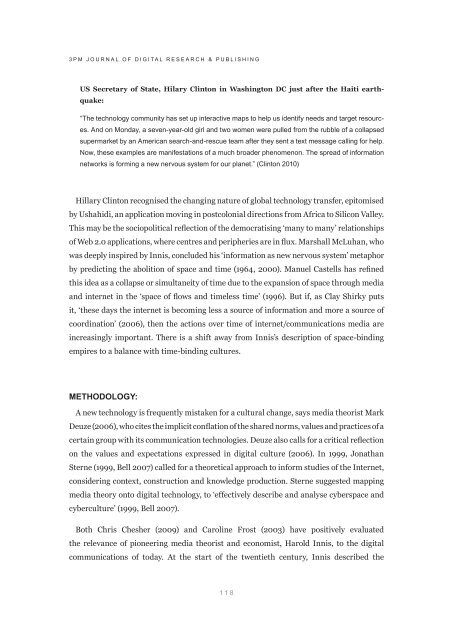3pm Journal of Digital research & publishing - artichoke web design
3pm Journal of Digital research & publishing - artichoke web design
3pm Journal of Digital research & publishing - artichoke web design
You also want an ePaper? Increase the reach of your titles
YUMPU automatically turns print PDFs into web optimized ePapers that Google loves.
<strong>3pm</strong> <strong>Journal</strong> <strong>of</strong> <strong>Digital</strong> <strong>research</strong> & <strong>publishing</strong><br />
US Secretary <strong>of</strong> State, Hilary Clinton in Washington DC just after the Haiti earth-<br />
quake:<br />
“the technology community has set up interactive maps to help us identify needs and target resourc-<br />
es. and on monday, a seven-year-old girl and two women were pulled from the rubble <strong>of</strong> a collapsed<br />
supermarket by an american search-and-rescue team after they sent a text message calling for help.<br />
now, these examples are manifestations <strong>of</strong> a much broader phenomenon. the spread <strong>of</strong> information<br />
networks is forming a new nervous system for our planet.” (clinton 2010)<br />
Hillary Clinton recognised the changing nature <strong>of</strong> global technology transfer, epitomised<br />
by Ushahidi, an application moving in postcolonial directions from Africa to Silicon Valley.<br />
This may be the sociopolitical reflection <strong>of</strong> the democratising ‘many to many’ relationships<br />
<strong>of</strong> Web 2.0 applications, where centres and peripheries are in flux. Marshall McLuhan, who<br />
was deeply inspired by Innis, concluded his ‘information as new nervous system’ metaphor<br />
by predicting the abolition <strong>of</strong> space and time (1964, 2000). Manuel Castells has refined<br />
this idea as a collapse or simultaneity <strong>of</strong> time due to the expansion <strong>of</strong> space through media<br />
and internet in the ‘space <strong>of</strong> flows and timeless time’ (1996). But if, as Clay Shirky puts<br />
it, ‘these days the internet is becoming less a source <strong>of</strong> information and more a source <strong>of</strong><br />
coordination’ (2006), then the actions over time <strong>of</strong> internet/communications media are<br />
increasingly important. There is a shift away from Innis’s description <strong>of</strong> space-binding<br />
empires to a balance with time-binding cultures.<br />
METHODOLOGY:<br />
A new technology is frequently mistaken for a cultural change, says media theorist Mark<br />
Deuze (2006), who cites the implicit conflation <strong>of</strong> the shared norms, values and practices <strong>of</strong> a<br />
certain group with its communication technologies. Deuze also calls for a critical reflection<br />
on the values and expectations expressed in digital culture (2006). In 1999, Jonathan<br />
Sterne (1999, Bell 2007) called for a theoretical approach to inform studies <strong>of</strong> the Internet,<br />
considering context, construction and knowledge production. Sterne suggested mapping<br />
media theory onto digital technology, to ‘effectively describe and analyse cyberspace and<br />
cyberculture’ (1999, Bell 2007).<br />
Both Chris Chesher (2009) and Caroline Frost (2003) have positively evaluated<br />
the relevance <strong>of</strong> pioneering media theorist and economist, Harold Innis, to the digital<br />
communications <strong>of</strong> today. At the start <strong>of</strong> the twentieth century, Innis described the<br />
118


